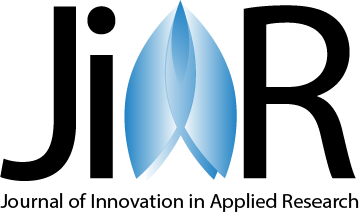
Prevalence and Characterization of Waterborne Multi Drug Resistant E. Coli O157:H7
13
Views
15
Downloads
The water samples were collected from pre-identified spots. To isolate E. coli from the water samples a number of nutrient media with selective substrates were used. MacConkey agar plates are used to differentiate by fermenting lactose. Lactose fermenting strains which grew as red or pink. MUG-EC broth was used for in the E. coli strains. Lastly, confirmation of selected suspected E. coli 0157:H7 isolates were taken to test for indole production test and methyl red red. Four sampling sites S1, S2, S5 & S6 were found positive for the presence of E. coli 0157:H7. Isolated virulent bacteria were further characterized based on the presence of stx2 gene that codes for shiga like toxins. The product targeting Stx2 of 485 bp was found in all suspected E. coli isolates from the sampling site S1, S2, S3 & S6. This four E. coli strains possessed virulence marker Stx–2 gene as tested by PCR. Phylogenetic relationship among isolated bacteria was determined by the sequence analysis of 16S rDNA gene. The specific oligomers target 16S RNA sequence of E. coli and 100% sequence similarity was found with the reference sequence after BLAST analysis of most conserved region of 16S r DNA gene. Antimicrobial susceptibility testing revealed the multi drug resistant pattern of isolates. All E. coli isolates were resistant to ampicillin, 6 isolates were resistant to erythromycin, 4 isolates were resistant to tetracyclin, and 2 isolates were resistant to kanamycin
<?xml version="1.0" encoding="UTF-8" standalone="yes"?>
<!DOCTYPE article PUBLIC "-//NLM//DTD JATS (Z39.96) Journal Publishing DTD v1.2d1 20170631//EN" "JATS-journalpublishing1.dtd">
<article xlink="http://www.w3.org/1999/xlink" dtd-version="1.0" article-type="applied-microbiology" lang="en">
<front>
<journal-meta>
<journal-id journal-id-type="publisher">JIAR</journal-id>
<journal-id journal-id-type="nlm-ta">Journ of innovation in applied research</journal-id>
<journal-title-group>
<journal-title>Journal of Innovation in Applied Research</journal-title>
<abbrev-journal-title abbrev-type="pubmed">Journ of innovation in applied research</abbrev-journal-title>
</journal-title-group>
<issn pub-type="ppub">2231-2196</issn>
<issn pub-type="opub">0975-5241</issn>
<publisher>
<publisher-name>Radiance Research Academy</publisher-name>
</publisher>
</journal-meta>
<article-meta>
<article-id pub-id-type="publisher-id">58</article-id>
<article-id pub-id-type="doi">10.51323/JIAR.1.1.2018.18-24</article-id>
<article-id pub-id-type="doi-url"/>
<article-categories>
<subj-group subj-group-type="heading">
<subject>Applied Microbiology</subject>
</subj-group>
</article-categories>
<title-group>
<article-title>Prevalence and Characterization of Waterborne Multi Drug Resistant E. Coli O157:H7
</article-title>
</title-group>
<contrib-group>
<contrib contrib-type="author">
<name>
<surname>Singh</surname>
<given-names>Shilpi</given-names>
</name>
</contrib>
<contrib contrib-type="author">
<name>
<surname>Bagri</surname>
<given-names>Anita</given-names>
</name>
</contrib>
<contrib contrib-type="author">
<name>
<surname>Verma</surname>
<given-names>Shivpal</given-names>
</name>
</contrib>
<contrib contrib-type="author">
<name>
<surname>Choure</surname>
<given-names>Kamlesh</given-names>
</name>
</contrib>
</contrib-group>
<pub-date pub-type="ppub">
<day>30</day>
<month>10</month>
<year>2018</year>
</pub-date>
<volume>1</volume>
<issue/>
<fpage>18</fpage>
<lpage>24</lpage>
<permissions>
<license license-type="open-access" href="http://creativecommons.org/licenses/by/4.0/">
<license-p>This is an open-access article distributed under the terms of the Creative Commons Attribution (CC BY 4.0) Licence. You may share and adapt the material, but must give appropriate credit to the source, provide a link to the licence, and indicate if changes were made.</license-p>
</license>
</permissions>
<abstract>
<p/>
</abstract>
<kwd-group>
<kwd>Water-borne disease</kwd>
<kwd>E. coli</kwd>
<kwd>MUG</kwd>
<kwd>Shiga toxin</kwd>
<kwd>Multi drug resistance</kwd>
<kwd>Microbiology</kwd>
<kwd>Biotechnology</kwd>
</kwd-group>
</article-meta>
</front>
</article>
1. Chen, J. and M.W. Griffiths (1998). PCR differentiation of Escherichia coli from other gram negative bacteria using primers derived from the nucleotide sequences flanking the gene encoding the universal stress protein. Letters in App. Microbiol., 27: 369–371.
2. Ji-Yeon, K., K. So-Hyun, K. Nam-Hoon, B. Won-Ki, L. Ji-Youn, K. HyeCheong, K. Jun-Man, N. Kyoung-Min, J. Woo-Kyung, P. Kun-Taek, and P. Yong-Ho (2005). Isolation and identification of Escherichia coli O157:H7 using different detection methods and molecular determination by multiplex PCR and RAPD. J. Vet. Sci., 6: 7– 19.
3. Johnson, R.P., R.C. Clarke, J.P. Wilson, S.C. Read, K. Rahn, S.A. Renwick, K.A. Sandhu, D. Alves, M.A. Karmali, H. Lior, S.A. McEwen, J.S. Spika and C.L. Gyles, (1996). Growing concerns and recent outbreaks involving non-O157:H7 serotypes of verotoxigenic E. coli. J. Food Prot., 59: 1112-1122.
4. Jones, D.L. (1999). Potential health risks associated with the persistence of Escherichia coli O157:H7 in agricultural environments. Soil. Use Manag., 15: 76–83.
5. O’Brien, A. D. and R. K. Holmes. 1987. Shiga and Shiga-like toxins. Microbiol. Rev. 51. 206-220.
6. Osek, J. (2001). Genetic identification of virulence markers in shiga toxin producing E. coli (STEC) strains.45. 37-42.
7. Stephen, M.O., J.M. Kobayashi, and J.H. Lewis (1989). Infections with Escherichia coli 0157:H7 in Washington State. J. American. Med. Asso., 262: 355-359.
8. Su, C.Y. and L.J. Brandt (1995). Escherichia coli O157:H7 infections in humans. Ann. Int. Med., 123: 698–714.
9. Thompson, J. S., D. S. Hodge, and A. A. Borczyk. 1990. Rapid biochemical test is identify verocytotoxin-positive strains of Escherichia coli serotype 0157. J Clin. Microbiol.
10. Van Boeckel, T. P., Brower, C., Gilbert, M., Grenfell, B. T., Levin, S. Robinson, T. P. 2015. Global Trends in Antimicrobial Use in Food Animals. Proceedings of the National Academy of Sciences, 112(18):5649-54. http://doi.org/10.1073/pnas.1503141112.
11. Wayne, P. A. 2012 Clinical and Laboratory Standards Institute (CLSI). Performance standards for antimicrobial susceptibility testing; Twenty-second informational supplement.
12. Suthanthiraraj, S. A., & Sheeba, D. J. (2007). Structural investigation on PEO based polymer electrolytes dispersed with Al2O3 nanoparticles. Ionics,13(6), 447–450.
13. Zou, G. X., Jin, P. Q., & Xin, L. Z. (2008). Extruded Starch/PVA Composites: Water Resistance, Thermal Properties, and Morphology. Journal of Elastomers and Plastics, 40, 303-312.